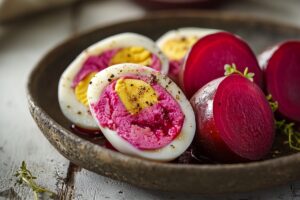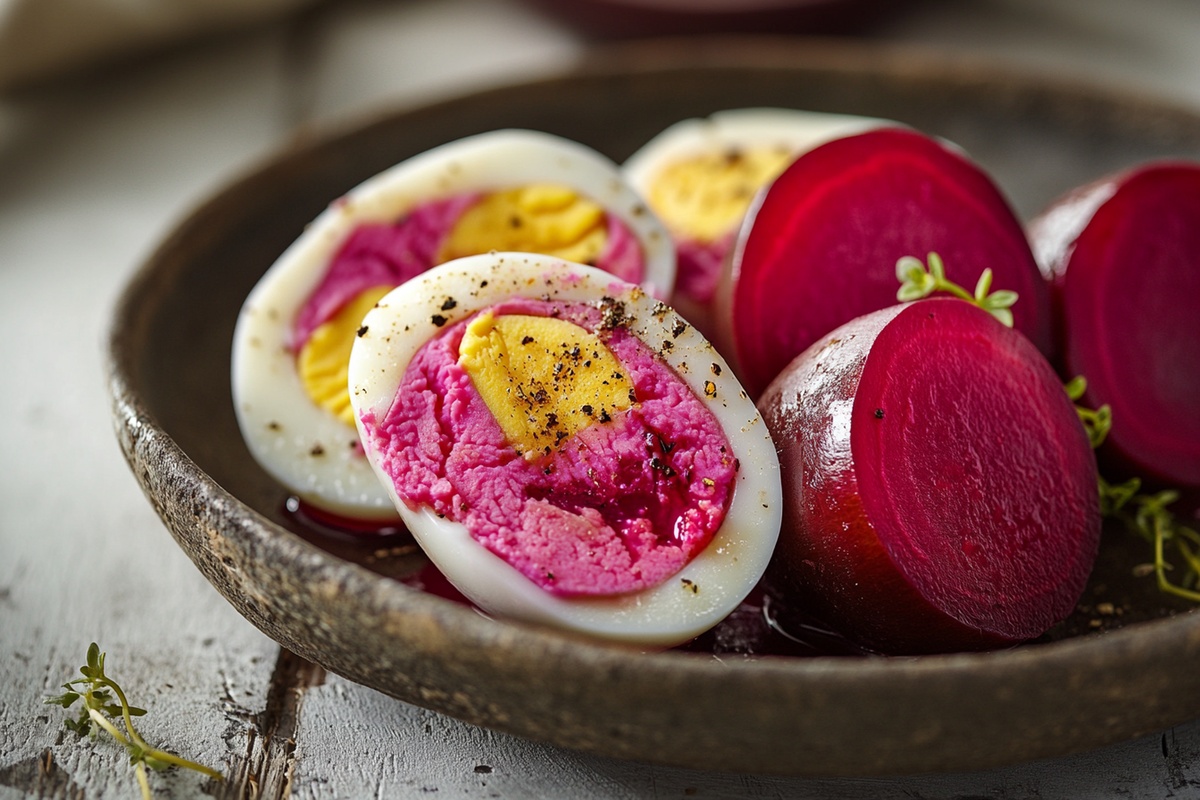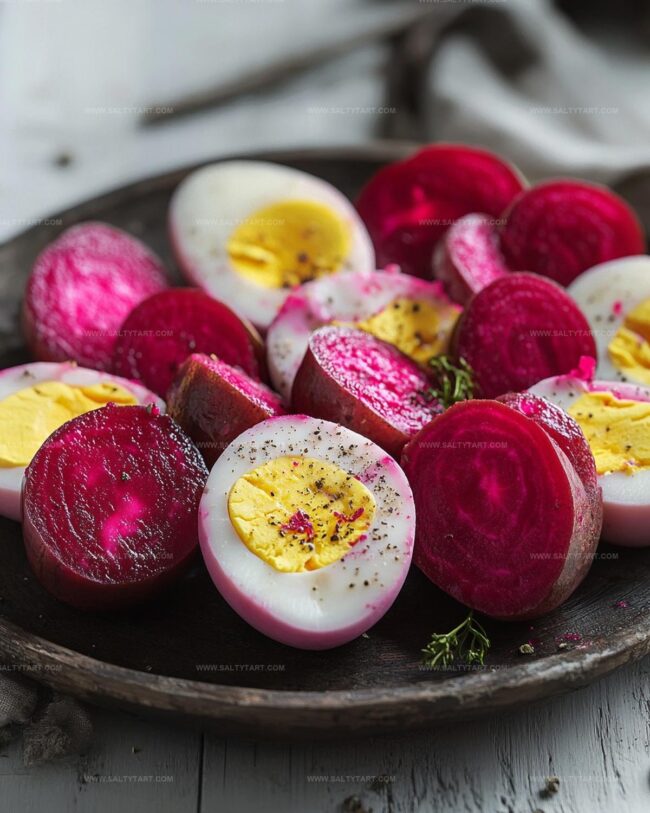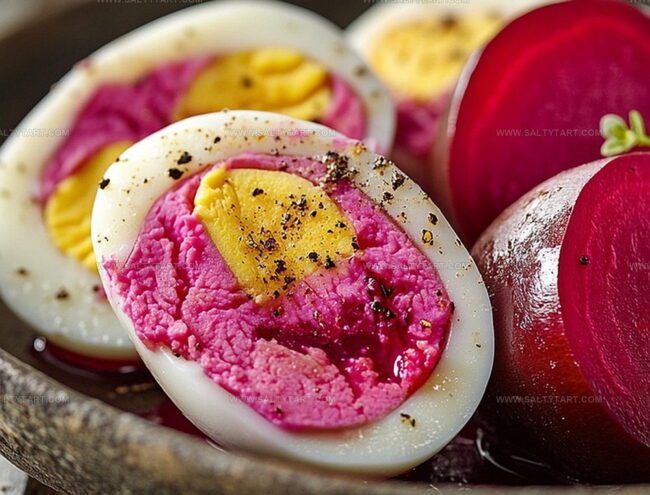Tangy Pickled Eggs with Beets Recipe: A Colorful Classic
Have you ever wondered how pickled eggs with beets can turn an ordinary snack into a vibrant culinary adventure?
Bright magenta hues peek through glass jars, promising tangy delights.
Crisp egg whites absorb deep crimson colors from sweet beet juice.
Vinegar and spices dance together, creating a zesty flavor profile that surprises and delights.
Sharp notes mingle with creamy textures, making each bite a complex experience.
Polish traditions inspire this simple yet elegant recipe that brings color and excitement to your table.
Fall in love with these ruby-stained eggs that will transform your next gathering into a memorable feast.
Pickled Eggs with Beets: Tangy and Colorful Snack
Ingredients for Pickled Eggs with Beets
Main Ingredients:Pickling Liquid Components:Aromatic Spices and Herbs:How to Prepare Pickled Eggs with Beets
Step 1: Boil Eggs with Precision
Select fresh eggs and place them gently into a pot of water. Bring the water to a rolling boil over high heat.
Cook the eggs for 9-10 minutes, ensuring they reach perfect hard-boiled consistency. Immediately transfer the eggs to a waiting ice bath, creating a shocking cold environment that stops the cooking process.
Once completely cooled, carefully peel away the shells, revealing smooth, pristine egg surfaces.
Step 2: Craft Vibrant Pickling Liquid
Gather your flavor-packed ingredients:Combine all ingredients in a saucepan.
Bring the mixture to a vigorous boil, then reduce heat and let it simmer for 5 minutes. The liquid will become a fragrant, aromatic solution that promises incredible flavor infusion.
Step 3: Create Colorful Pickle Jar
Select a clean glass jar or container. Layer the peeled eggs and sliced beets carefully.
Pour the hot pickling liquid over the ingredients, making sure every morsel is completely submerged. The beets will begin to bleed their gorgeous deep purple color, creating a stunning visual effect.
Step 4: Develop Rich Flavors
Seal the jar tightly with a lid. Place in the refrigerator and let the magic happen.
Allow the eggs to pickle for a minimum of 24 hours, though 3-5 days will develop even more complex, tantalizing flavors. The longer the eggs rest, the more intense and delightful they become.
Tips for Balanced Pickling Flavors
Creative Twists on Pickled Eggs with Beets
Pairing Ideas for Pickled Eggs
Arrange pickled eggs alongside creamy goat cheese, sharp cheddar, cured salami, and crusty sourdough bread for a vibrant appetizer experience.
Select a chilled, acidic white wine that cuts through the pickled eggs’ richness and enhances their bright, zingy flavor profile.
Create an open-faced sandwich using dense rye bread, spread with whole grain mustard, topped with sliced pickled eggs and fresh dill for a robust meal.
Choose a light, refreshing beer with subtle hop notes that balances the tangy, earthy undertones of the pickled eggs and beets.
Storage Recommendations for Pickled Eggs
FAQs
The eggs develop a tangy, slightly sweet flavor with earthy undertones from the beets, creating a unique and zesty taste experience that’s both refreshing and complex.
Pickled eggs are protein-rich and low in calories. They provide essential nutrients like vitamin D, B12, and minerals while offering a probiotic boost from the fermentation process.
Fresh beets provide better texture and flavor, but canned beets work as a convenient alternative. Just ensure they are sliced or diced before adding to the pickling liquid.
When properly sealed and refrigerated, pickled eggs can last up to 3-4 weeks, maintaining their flavor and quality throughout storage.
Print
Pickled Eggs With Beets Recipe
- Total Time: 25 minutes
- Yield: 6 1x
Description
Pickled eggs with beets offer a delightful fusion of tangy and earthy flavors that dance across your palate. Crisp, ruby-red eggs make an irresistible appetizer or protein-packed snack for culinary adventurers seeking bold, colorful refreshment.
Ingredients
Pickled Eggs with Beets Ingredients:
Main Ingredients:
- 6 large eggs
- 1 cup cooked beets, sliced (or 1 can of sliced beets)
Pickling Liquid:
- 1 cup apple cider vinegar
- 1/2 cup water
- 1/4 cup sugar
- 1 teaspoon salt
Spices and Aromatics:
- 1/2 teaspoon black peppercorns
- 1/2 teaspoon mustard seeds
- 2 cloves garlic, peeled and smashed
- 2 bay leaves
Instructions
- Prepare a pot of boiling water, then gently lower eggs into the bubbling liquid. Cook for precisely 9-10 minutes to achieve the perfect hard-boiled texture.
- Immediately transfer eggs to an ice bath, allowing them to cool completely. Once chilled, carefully remove the shells, creating smooth, pristine egg surfaces.
- Craft the pickling elixir by combining apple cider vinegar, water, and seasonings in a saucepan. Bring the aromatic mixture to a rolling boil, then reduce heat and let it simmer for 5 minutes, allowing the spices to meld and intensify.
- Select a clean, spacious jar and artfully arrange the peeled eggs alongside vibrant beet slices. Pour the still-steaming pickling liquid over the ingredients, ensuring complete submersion.
- Seal the jar tightly and transfer to the refrigerator. Allow the eggs to marinate and absorb the complex flavors for a minimum of 24 hours, though 3-5 days will yield a more robust and nuanced taste profile.
Notes
- Master perfect hard-boiled eggs by using room temperature eggs to prevent cracking and ensure even cooking.
- Select fresh, high-quality eggs with firm whites for the best pickling texture and appearance.
- Experiment with different vinegar types like rice or white wine vinegar to create unique flavor profiles.
- Adjust salt and sugar levels to accommodate low-sodium or diabetic dietary requirements without compromising taste.
- Prep Time: 15 minutes
- Cook Time: 10 minutes
- Category: Appetizer, Snacks
- Method: Boiling
- Cuisine: American
Nutrition
- Serving Size: 6
- Calories: 74 kcal
- Sugar: 4 g
- Sodium: 291 mg
- Fat: 4 g
- Saturated Fat: 1.3 g
- Unsaturated Fat: 2.5 g
- Trans Fat: 0 g
- Carbohydrates: 6 g
- Fiber: 1.3 g
- Protein: 7 g
- Cholesterol: 186 mg





Mike Reynolds
Founder & Recipe Developer
Expertise
Farm-to-table cuisine, Seasonal recipe development, Sustainable cooking techniques, Food photography
Education
Asheville-Buncombe Technical Community College (A-B Tech)
Associate Degree in Culinary Arts
Mike studied culinary arts with a strong focus on farm-to-table principles and sustainable cooking. His training emphasized the importance of fresh, local ingredients and environmentally responsible practices in the kitchen.
Mike’s food journey began deep in the Blue Ridge Mountains, where weekends at farmers’ markets and home-cooked meals sparked a lifelong obsession with simple, seasonal eating.
After earning his Associate Degree in Culinary Arts from Asheville-Buncombe Technical Community College, he set out to bring farm-to-table cooking into everyday kitchens, without the fuss.
Mike’s philosophy is all about keeping it fresh, unfussy, and full of heart. When he’s not crafting new single-serving recipes, he’s hiking mountain trails, chatting with local farmers, or experimenting with wild ingredients in his backyard kitchen.